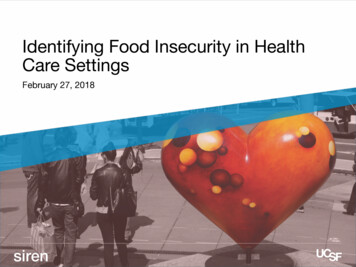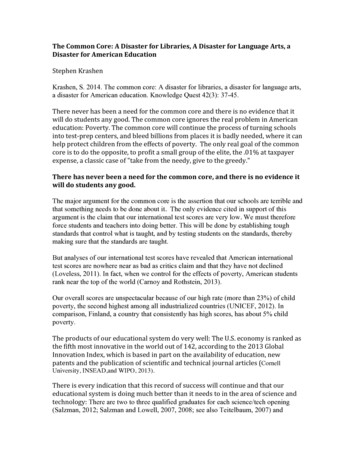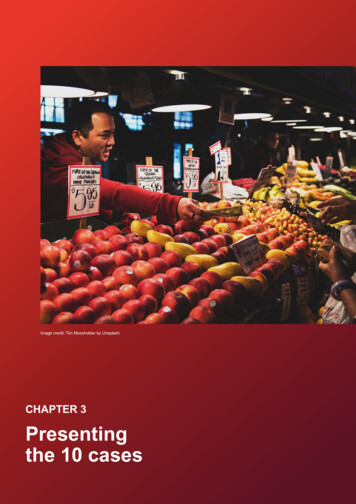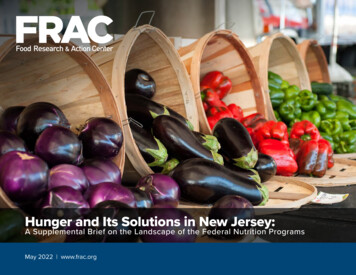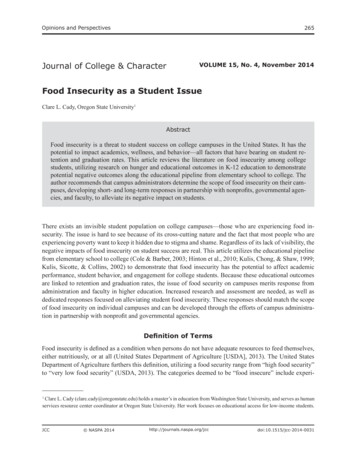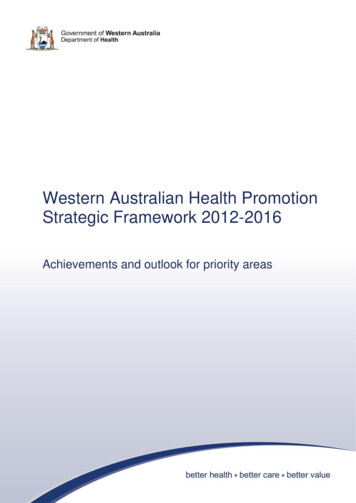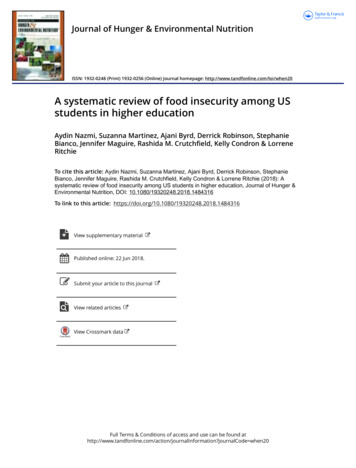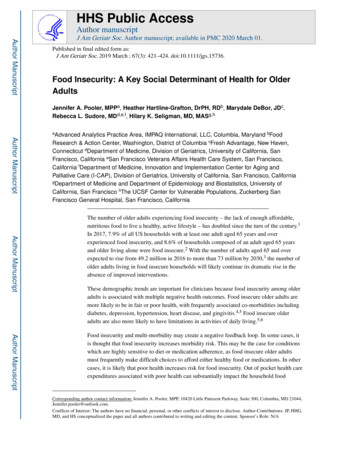
Transcription
HHS Public AccessAuthor manuscriptAuthor ManuscriptJ Am Geriatr Soc. Author manuscript; available in PMC 2020 March 01.Published in final edited form as:J Am Geriatr Soc. 2019 March ; 67(3): 421–424. doi:10.1111/jgs.15736.Food Insecurity: A Key Social Determinant of Health for OlderAdultsJennifer A. Pooler, MPPa, Heather Hartline-Grafton, DrPH, RDb, Marydale DeBor, JDc,Rebecca L. Sudore, MDd,e,f, Hilary K. Seligman, MD, MASg,hAuthor ManuscriptaAdvancedAnalytics Practice Area, IMPAQ International, LLC, Columbia, Maryland bFoodResearch & Action Center, Washington, District of Columbia cFresh Advantage, New Haven,Connecticut dDepartment of Medicine, Division of Geriatrics, University of California, SanFrancisco, California eSan Francisco Veterans Affairs Health Care System, San Francisco,California fDepartment of Medicine, Innovation and Implementation Center for Aging andPalliative Care (I-CAP), Division of Geriatrics, University of California, San Francisco, CaliforniagDepartment of Medicine and Department of Epidemiology and Biostatistics, University ofCalifornia, San Francisco hThe UCSF Center for Vulnerable Populations, Zuckerberg SanFrancisco General Hospital, San Francisco, CaliforniaAuthor ManuscriptThe number of older adults experiencing food insecurity – the lack of enough affordable,nutritious food to live a healthy, active lifestyle – has doubled since the turn of the century.1In 2017, 7.9% of all US households with at least one adult aged 65 years and overexperienced food insecurity, and 8.6% of households composed of an adult aged 65 yearsand older living alone were food insecure.2 With the number of adults aged 65 and overexpected to rise from 49.2 million in 2016 to more than 73 million by 2030,3 the number ofolder adults living in food insecure households will likely continue its dramatic rise in theabsence of improved interventions.These demographic trends are important for clinicians because food insecurity among olderadults is associated with multiple negative health outcomes. Food insecure older adults aremore likely to be in fair or poor health, with frequently associated co-morbidities includingdiabetes, depression, hypertension, heart disease, and gingivitis.4,5 Food insecure olderadults are also more likely to have limitations in activities of daily living.5,6Author ManuscriptFood insecurity and multi-morbidity may create a negative feedback loop. In some cases, itis thought that food insecurity increases morbidity risk. This may be the case for conditionswhich are highly sensitive to diet or medication adherence, as food insecure older adultsmust frequently make difficult choices to afford either healthy food or medications. In othercases, it is likely that poor health increases risk for food insecurity. Out of pocket health careexpenditures associated with poor health can substantially impact the household foodCorresponding author contact information: Jennifer A. Pooler, MPP, 10420 Little Patuxent Parkway, Suite 300, Columbia, MD 21044,Jennifer.pooler@outlook.com.Conflicts of Interest: The authors have no financial, personal, or other conflicts of interest to disclose. Author Contributions: JP, HHG,MD, and HS conceptualized the paper and all authors contributed to writing and editing the content. Sponsor’s Role: N/A
Pooler et al.Page 2Author Manuscriptbudget. In addition, functional impairments (physical disability, limited visual acuity, poordentition, cognitive impairment, and social isolation) can make chronic disease selfmanagement both more challenging and more expensive.7 Access to healthy food in thispopulation may be further limited by challenges with transportation.As a result, clinicians may be regularly addressing the causes and consequences of foodinsecurity in the clinical setting, often without recognizing it or knowing how best to addressit.8 Challenges recognizing food insecurity can be exacerbated by the frequent cooccurrence of food insecurity and obesity in the US, as dietary intake in food insecurehouseholds frequently shifts away from healthier, more expensive foods and toward cheaperfoods which are typically more obesogenic.Author ManuscriptThere is good evidence, however, that programs that support food security can improvehealth outcomes and the likelihood of aging in place among older adults, suggesting thatclinical interventions are warranted. For example, participation in the SupplementalNutrition Assistance Program (SNAP), the largest food support system in the US, isassociated with reductions in avoidable health care utilization, including nursing home stays,hospitalizations, and emergency department visits.9,10 SNAP participation is also associatedwith reductions in cost-related medication nonadherence among food-insecure older adults.11Clinician’s RoleAuthor ManuscriptWhile food insecurity poses challenges for maintaining health and preventing chronicdisease complications, the frequency with which many older adults interact with the healthsystem provides opportunities for integrating discussions about health needs, food security,and community resources for food and nutrition. Food insecurity may at times be addressedas part of routine clinical care. For example, a frail, homebound older adult may present asmalnourished and be referred for home-delivered meals—incidentally addressing thepatient’s food insecurity through treatment of a medical condition. Other times, lack ofrecognition of food insecurity may hamper clinical care. For instance, a clinician treating anolder adult with diabetes experiencing frequent episodes of hypoglycemia may respond firstby reducing medication doses, rather than uncovering that the root cause of thehypoglycemia is an inability to afford food--a barrier that could be better addressed byreferral to a food and nutrition support program.Author ManuscriptHealth systems and providers across the US are therefore adopting systems for screening forfood insecurity in the clinical setting and referring food insecure patients to appropriateservices in order to support their patients in managing chronic disease, maintaining health,and continuing independent living. To best support older adults, clinicians can consider threeactivities:1.Screen Patients– Unlike other nutrition-related complications, like obesity orfrailty, food insecurity may be episodic and hidden from view. Thereforescreening programs are essential. Because of elevated risk, all older adults shouldbe screened for food insecurity at least once, such as at the time of the MedicareTotal Health Assessment.12 More frequent screening should be considered forJ Am Geriatr Soc. Author manuscript; available in PMC 2020 March 01.
Pooler et al.Page 3Author Manuscriptpopulations at greatest risk, including Medicaid and dual Medicare-Medicaidenrollees and patients with multiple co-morbidities (especially if they includemalnourishment, failure to thrive, diabetes, or depression). The Hunger VitalSign , a two-item screening tool, has been validated for clinical use and ishighly sensitive and specific among older adults.13 Its use among older adults hasbeen endorsed by multiple organizations, including the AARP Foundation.2.Author ManuscriptIntervene Clinically – Clinicians and practice teams should become familiarwith and refer food insecure patients to publicly or privately funded nutritionprograms known to support food security (Table 1), ideally by creating systemsthat make such referrals time-efficient. Such programs include SNAP, congregatemeals, and home-delivered meals, all of which are supported to some extent byfederal funding. In addition to supporting food security and improved dietaryintake, these programs are associated with reductions in isolation, depression,preventable health care utilization, and health care costs.9,10,14–16Under-enrollment in SNAP is of particular concern for older adults. Fewer thanhalf of eligible older adults participate in SNAP, despite its proven healthbenefits and entitlement structure.17 Common barriers to SNAP participationamong older adults include cumbersome state or local application processes,misunderstanding of program benefits, lack of eligibility awareness, and stigma.18 Clinicians and health systems are in a unique position to address many ofthese barriers, such as reframing food assistance as a benefit that can supporthealth and independence.3.Author ManuscriptAdvocate for Systems Change – Clinicians play a critical role in advocating forpolicies, programs, and practices that support the health of their patients, such asSNAP and other community and federal nutrition programs. The experiences ofclinicians treating food insecure patients offer important insights for leaders.Three key advocacy opportunities for clinicians working with older adultsinclude: Promoting more widespread screening for food insecurity in theclinical setting, documentation in the medical record, and referrals tofood and nutrition resources; Closing the gap in older adult participation in SNAP; and Ensuring the dollar value of SNAP benefits is adequate to meet thedietary needs of older adults.Author ManuscriptTable 2 provides examples of specific clinical strategies and policy solutions related to theseopportunities. In addition, the Food Research & Action Center (FRAC; www.frac.org) andthe AARP Foundation (www.aarp.org/aarp-foundation) provide numerous resources andtools for local, state, and federal advocacy efforts focused on food insecurity and povertyamong older adults.J Am Geriatr Soc. Author manuscript; available in PMC 2020 March 01.
Pooler et al.Page 4Author ManuscriptOpportunities / Early SuccessesClinical programs and systems to screen for and intervene on food insecurity are beingscaled across the US. A 2017 review identified 22 health care entities that have implementedsystematic food insecurity screening programs for older adults.19 Kaiser PermanenteColorado and Hunger Free Colorado, for instance, entered into a partnership in 2011leveraging their unique assets to screen patients for food insecurity during clinical visits,refer food insecure patients to community specialists with expertise in community andfederal nutrition programs, and support enrollment in appropriate programming.20Author ManuscriptOther clinical systems have adopted on-site solutions. For example, ProMedica healthsystem has screened all patients for food insecurity since 2015. In the primary care setting,food insecure patients are referred to an on-site Food Pharmacy. In the inpatient setting,patients are provided with emergency food at hospital discharge, if needed.21,22Clinician Resources for Addressing Food Insecurity among Older AdultsA number of resources exist to help clinicians identify and address food insecurity amongolder adults.Author ManuscriptAuthor Manuscript Screen and Intervene: Addressing Food Insecurity Among Older Adults is afree, online course for clinicians that describes risk factors for food insecurityamong older adults; negative health outcomes associated with food insecurityamong older adults; the Hunger Vital Sign screening tool; and strategies toconnect older adults to SNAP and other appropriate resources(www.seniorhealthandhunger.org). Implementing Food Security Screening and Referrals for Older Patients inPrimary Care: A Resource Guide and Toolkit is intended to aid clinicians inimplementing systematic food security screening and referral processes(www.impaqint.com/OASDOH). Clinical Algorithms exist to support clinicians in screening and appropriatelyresponding to food insecurity. The CDC’s Nutrition and Obesity Policy Researchand Evaluation Network (NOPREN) algorithm provides clinicians with simplesteps tailored to older adults (www.nopren.org/working groups/hunger-safetynet/clinical-linkages/). Combating Food Insecurity: Tools for Helping Older Adults Access SNAPoffers practical tips to organizations of all sizes interested in supporting olderadults with SNAP enrollment through education, outreach, and applicationassistance ccess-snap-2).ConclusionsFood security is important for the physical and mental health of older adults. Clinicians canaddress food insecurity among older adults by systematically screening patients for foodinsecurity, intervening when a food insecure patient is identified to establish a connectionJ Am Geriatr Soc. Author manuscript; available in PMC 2020 March 01.
Pooler et al.Page 5Author Manuscriptwith a program supporting food security, and advocating for policies, programs, andpractices that reduce food insecurity among older adults.AcknowledgmentsWe acknowledge the following Nutrition and Obesity Policy Research and Evaluation Network (NOPREN)members who participated in developing this Editorial: Sandra Stenmark, MD, Kaiser Permanete, Colorado;Sanjana Marpadga, MSc, UCSF Center for Vulnerable Populations at Zuckerberg San Francisco General Hospitaland Trauma Center. None of these individuals were compensated for their contributions.The authors of this publication are members of the Food Security working group, part of the Nutrition and ObesityPolicy Research and Evaluation Network (NOPREN). NOPREN is supported by Cooperative Agreement no.5U48DP00498–05 from the Centers for Disease Control and Prevention, Prevention Research Centers Program. Dr.Sudore is funded in part by a National Institutes of Health, National Institute on Aging K24AG054415 award. Thefindings in this publication are solely the responsibility of the authors and do not necessarily represent the officialviews of the CDC.Author ManuscriptReferencesAuthor ManuscriptAuthor Manuscript1. Ziliak J, Gundersen C. The State of Senior Hunger in America 2016: An Annual Report. Reportsubmitted to Feeding America and the National Foundation to End Senior Hunger; 2018.2. Coleman-Jensen A, Rabbitt MP, Gregory CA, Singh A. Household Food Security in the UnitedStates in 2017, ERR-256. Washington, DC; 2018.3. U.S. Census Bureau Population Division. Projected 5-Year Age Groups and Sex Composition: MainProjections Series for the United States, 2017–2060: National Population Projections Tables.Washington, DC.; 2017 Retrieved 7/14/18 oj/2017-summary-tables.html.4. Ziliak JP, Gundersen C. The Health Consequences of Senior Hunger in the United States: Evidencefrom the 1999–2014 NHANES. Report submitted to Feeding America; 2017.5. Venci BJ, Lee SY. Functional limitation and chronic diseases are associated with food insecurityamong U.S. adults. Ann Epidemiol. 2018;28(3):182–188. doi:10.1016/j.annepidem.2018.01.005.[PubMed: 29482742]6. Bishop NJ, Wang K. Food insecurity, comorbidity, and mobility limitations among older U.S. adults:Findings from the Health and Retirement Study and Health Care and Nutrition Study. Prev Med(Baltim). 2018;114(June):180–187. doi:10.1016/j.ypmed.2018.07.001.7. Jih J, Stijacic-Cenzer I, Seligman HK, Boscardin WJ, Nguyen TT, Ritchie CS. Chronic diseaseburden predicts food insecurity among older adults. Public Health Nutr. 2018;21(9):1737–1742. doi:10.1017/S1368980017004062. [PubMed: 29388533]8. American Geriatrics Society Expert Panel on the Care of Older Adults. Guiding principles for thecare of older adults with multimorbidity: An approach for clinicians. J Am Geriatr Soc.2012;60(10):1–25. doi:10.1111/j.1532-5415.2012.04188.x. [PubMed: 22239290]9. Szanton SL, Samuel LJ, Cahill R, et al. Food assistance is associated with decreased nursing homeadmissions for Maryland’s dually eligible older adults. BMC Geriatr. 2017. doi:10.1186/s12877-017-0553-x.10. Samuel LJ, Szanton SL, Cahill R, Wolff JL, Ong P, Zielinskie G. Does the Supplemental NutritionAssistance Program affect hospital utilization among older adults? The case of Maryland. PopulHealth Manag. 2017;0(0):1–8. doi:10.1089/pop.2017.0055.11. Srinivasan M, Pooler JA. Cost-Related Medication Nonadherence for Older Adults Participating inSNAP, 2013–2015. Am J Public Health. 2018;108(2):224–230. doi:10.2105/AJPH.2017.304176.[PubMed: 29267062]12. Steiner JF, Stenmark SH, Sterrett AT, et al. Food Insecurity in Older Adults in an Integrated HealthCare System. J Am Geriatr Soc. 2018. doi:10.1111/jgs.15285.13. Gundersen C, Engelhard EE, Crumbaugh AS, Seligman HK. Brief assessment of food insecurityaccurately identifies high-risk US adults. Public Health Nutr. 2017:1–5. doi:10.1017/S1368980017000180.J Am Geriatr Soc. Author manuscript; available in PMC 2020 March 01.
Pooler et al.Page 6Author ManuscriptAuthor ManuscriptAuthor Manuscript14. Lloyd JL, Wellman NS. Older Americans Act Nutrition Programs: A Community-Based NutritionProgram Helping Older Adults Remain at Home. J Nutr Gerontol Geriatr. 2015;34(2):90–109. doi:10.1080/21551197.2015.1031592. [PubMed: 26106983]15. Thomas KS, Akobundu U, Dosa D. More Than A Meal? A Randomized Control Trial Comparingthe Effects of Home-Delivered Meals Programs on Participants’ Feelings of Loneliness. JournalsGerontol - Ser B Psychol Sci Soc Sci. 2016;71(6):1049–1058. doi:10.1093/geronb/gbv111.16. Berkowitz SA, Seligman HK, Rigdon J, Meigs JB, Basu S. Supplemental Nutrition AssistanceProgram (SNAP) participation and health care expenditures among low-income adults. JAMAIntern Med. 2017;177(11):1642–1649. doi:10.1001/jamainternmed.2017.4841. [PubMed:28973507]17. Cunnyngham K Trends in Supplemental Nutrition Assistance Program Participation Rates: FiscalYear 2010 to Fiscal Year 2016. Washington, DC; 2018 /snap/Trends2010-2016.pdf.18. AARP Foundation, Food Research Action Center. Combating Food Insecurity: Tools for HelpigOlder Adults Access SNAP. Washington, DC; 2015 ccess-snap-2.19. Lundeen EA, Siegel KR, Calhoun H, et al. Clinical-Community Partnerships to Identify PatientsWith Food Insecurity and Address Food Needs. Prev Chronic Dis. 2017;14:170343. doi:10.5888/pcd14.170343.20. Stenmark S, Solomon L, Allen-Davis J, Brozena C. Linking The Clinical Experience ToCommunity Resources To Address Hunger In Colorado. Health Affairs Blog 0713.049277/full/. Published 2015. AccessedSeptember 20, 2018.21. Murthy VH. Food insecurity: A public health issue. Public Health Rep. 2016;131(5):655–657. doi:10.1177/0033354916664154. [PubMed: 28123203]22. Stenmark SH, Steiner JF, Marpadga S, Debor M, Underhill K, Seligman H. Lessons Learned fromImplementation of the Food Insecurity Screening and Referral Program at Kaiser PermanenteColorado. Perm J. 2018 10 05; 22.23. DeSilvey S, Ashbrook A, Sheward R, Hartline-Grafton H, Ettinger de Cuba S, Gottlieb L. AnOverview of Food Insecurity Coding in Health Care Settings Existing and Emerging OpportunitiesSpecial Note. Boston, MA; 2018 ng/.Author ManuscriptJ Am Geriatr Soc. Author manuscript; available in PMC 2020 March 01.
Pooler et al.Page 7Table 1:Author ManuscriptExamples of Federal and Local Food Assistance Programs for Older Adults*Author ManuscriptName of ProgramGeneral Program EligibilityProgram OverviewSupplemental NutritionAssistance Program(SNAP, formerly knownas “Food Stamps”)Low-income individuals who meet income and assettests (which can vary by state); there are specialprogram rules for adults aged 60 and olderMonthly benefits provided in the form of anElectronic Benefit Transfer (EBT) card that workslike a debit card to purchase food at SNAP-authorizedretailersCongregate MealProgramAdults aged 60 and older; preference is given to thosewith the greatest economic and social needProvides group meals at participating sites (e.g.,churches, senior housing, and other communityspaces)Home-Delivered MealsAdults aged 60 and older who are frail, homebound, orisolated; preference is given to those with the greatesteconomic and social needMeals delivered to place of residenceCommoditySupplemental FoodProgram (CSFP)Adults who are aged 60 and older and meet statespecific income thresholdsProvides a monthly food box of items, generallyreceived at a food pantrySenior Farmers MarketNutrition ProgramAdults aged 60 and older who are at or below 185percent of the federal poverty line, but some states tieeligibility to other means-tested program participationAnnual vouchers to use for eligible foods atparticipating farmers’ markets, roadside stands, andcommunity-supported agriculture programsChild and Adult CareFood Program (CACFP)Non-residential adult day care centers that serve adultsage 60 and older and/or individuals who arefunctionally impairedCACFP provides reimbursement to adult day carefacilities that serve nutritious snacks and meals toolder adultsFood pantriesTargeted to low-income people of all ages; eligibilitycriteria varyProvides free food and grocery items that are pickedup in-person by the individual or a proxyMedically-tailored mealsEligibility criteria varyHome delivered meals tailored to meet the needs of aspecific health condition or combination of conditions*Adapted with permission from the Food Research & Action Center’s Federal Nutrition Programs and Emergency Food Referral Chart for OlderAdults (2018). Primarily for use in health care settings, the referral chart includes key information on nutrition programs available to older adultsand can be tailored to include local resources. The chart is available at www.frac.org.Author ManuscriptAuthor ManuscriptJ Am Geriatr Soc. Author manuscript; available in PMC 2020 March 01.
Pooler et al.Page 8Table 2:Author ManuscriptStrategies for Reducing Food Insecurity among Older AdultsPromote screen and intervene efforts in clinical settingsClinical Strategies Educate peers, staff, and leadership on the connections between food insecurity and health through workshops, grand rounds, and discussionsat staff meetings. Champion implementation of systematic food security screening within the health system, ideally using the Hunger Vital Sign , includingdocumentation of the results in the medical record. * Create and regularly update food insecurity intervention processes in collaboration with the practice team. Connect patients who screenpositive for food insecurity to SNAP, congregate meals, home-delivered meals, and other community-based resources. Support the practice team in learning about the importance of food insecurity screening, administration of the screening tool, documentationof screening results, and intervention processes. Increase awareness of food insecurity in the broader community and identify community-based resources and partnerships that can benefitfood-insecure patients. Develop on-site food pharmacies, food pantries, or meal programs to provide food or meals to vulnerable patients and their families.Policy Solutions Use money from the health care system’s community benefit programs for screen and intervene programming in clinical settings. **Author ManuscriptClose the gap in older adult participation in SNAPClinical Strategies Work with community partners to enroll Medicaid beneficiaries in SNAP.Policy Solutions Streamline enrollment of SNAP eligible older adults by implementing an Elderly Simplified Application Project (ESAP) that shortens theSNAP application, provides 36 month certification period, and eliminates need for a recertification interview for some older adults. Enable clients to apply for SNAP using telephonic signatures. Leverage data from other programs, such as Supplemental Security Income (SSI) and Medicaid, to streamline enrollment of low-income olderadults onto SNAP. Invest in SNAP education and application assistance projects to help older adults navigate the complex SNAP enrollment and recertificationprocesses.Ensure the dollar value of the SNAP benefit is adequate to meet the dietary needs of older adultsAuthor ManuscriptClinical Strategies Engage with local hunger or food policy councils to add expert health professional perspectives to important policy discussions. Insure on-site nutrition education is sensitive to the needs of food insecure patients, particularly the need for budget-neutral strategies toimprove dietary intake.Policy Solutions Establish a SNAP Standard Medical Deduction (SMD) to simplify the process by which older adults can have excess medical costs taken intoconsideration in determining SNAP benefit levels. Coordinate SNAP and low-income energy payments to provide older adults enrolled in SNAP with appropriate utility deductions and SNAPbenefit levels that better position them to avoid competing “heat or eat” demands. Use state or local government funding to supplement the 15 federal minimum monthly SNAP benefit received by many older adult SNAPparticipants*An Overview of Food Insecurity Coding in Health Care Settings Existing and Emerging Opportunities describes how to record food security inthe health record ing/)23**The Delivering Community Benefit: Healthy Food Playbook describes this strategy (foodcommunitybenefit.noharm.org).22Author ManuscriptJ Am Geriatr Soc. Author manuscript; available in PMC 2020 March 01.
Clinical programs and systems to screen for and intervene on food insecurity are being scaled across the US. A 2017 review identified 22 health care entities that have implemented systematic food insecurity screening programs for older adults.19 Kaiser Permanente Colorado and Hunger Free Colorado, for instance, entered into a partnership in 2011

